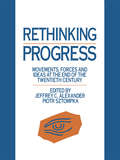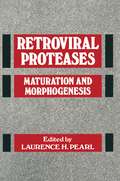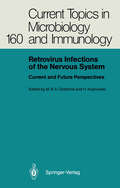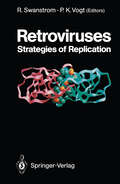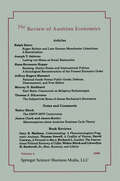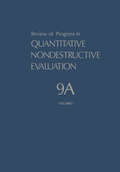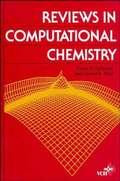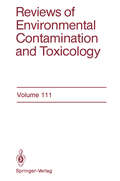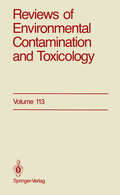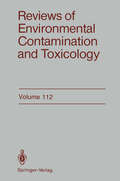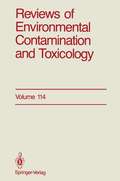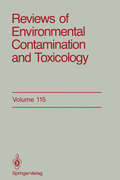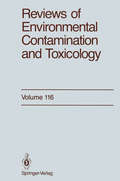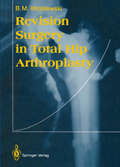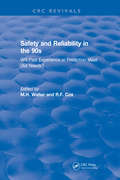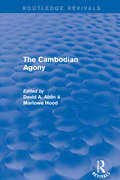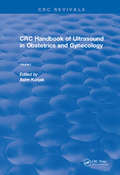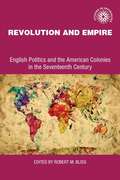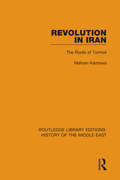- Table View
- List View
Rethinking Progress: Movements, Forces, and Ideas at the End of the Twentieth Century
by Jeffrey C. Alexander Piotr SztompkaRethinking Progress provides a challenging reevaluation of one of the crucial ideas of Western civilization; the notion of progress. Progress often seems to have become self-defeating, producing ecological deserts, overpopulated cities, exhausted resources, decaying cultures, and widespread feelings of alienation. The contributors, from all over the world, present their diversified perspectives on the fate of progress.
Retroviral Proteases: Control of maturation and morphogenesis
This volume describes the state-of-the-art of our understanding of the structure and function of retroviral proteases, and their substrates, the viral polyproteins, described by the leading workers in the field. The contributions range from detailed biochemical and structural characterisation of several retroviral proteases including that from HIV-1, through the analysis of the proteolytic processing of the viral polyproteins, to the structure of the viral capsids formed by the action of the protease, and is essential reading for anyone interested in the molecular biology of AIDS.
Retrovirus Infections of the Nervous System: Current and Future Perspectives (Current Topics in Microbiology and Immunology #160)
by Michael B. A. Oldstone Hilary KoprowskiAlthough retroviruses have long been associated with a variety of animal diseases, active research in the field of human retroviruses dates from the discovery of human immunodefici ency virus (HIV) in association with acquired immunodefici ency syndrome (AIDS). The enormous research efforts in this field have been directed toward understanding the nature of the virus and toward its elimination through preventive vaccin ation and the cure of the disease. Human T-cell leukemia virus (HTLV-l) was the first member of the human retrovirus family to be discovered. It was implicated as the cause of adult T-cell leukemia (ATL) even before the association of HIV and AIDS was established. Research on HTL V -1 has, however, been lagging behind that of HIV because of the importance of AIDS. Today HTLV-1 and possibly closely related HTLV-2 are associated with a variety of human neurologic diseases, and research activities in this field may show that human retroviruses can cause a variety of human diseases in addition to those affecting the nervous system. Papers in this volume attempt to acquaint the reader with the present state of research into retrovirus infection and related diseases of the nervous system.
Retroviruses: Strategies of Replication (Current Topics in Microbiology and Immunology #157)
by Ronald Swanstrom Peter VogtReview of Progress in Quantitative Nondestructive Evaluation (Review of Progress in Quantitative Nondestructive Evaluation #9)
by Donald O. Thompson Dale E. ChimentiThis volume (Parts A and B) contains the edited papers presented at the annual Review of Progress in Quantitative Nondestructive Evaluation held at Bowdoin College, Brunswick, ME on July 24-28, 1989. The Review was organized by the Center for Advanced NDE at the Ames Laboratory of the U. S. Department of Energy, in cooperation with the Office of Basic Energy Sciences, USDOE, and the Materials Laboratory at Wright-Patterson Air Force Base. The statistics for the 1989 Review of Progress in QNDE include a total of over 460 participants from the U. S. and nine foreign countries who presented some 325 papers. Over the years this conference has grown into one of the largest, most significant gatherings of NDE researchers and engineers in the world. The meeting was divided into 35 sessions, with as many as four sessions running concurrently, and covering all stages of NDE development from basic research investigations to early engineering applications and all methods of inspection science from ultrasonics to x-ray tomography. The Editors have organized the papers in the Proceedings according to topical subject headings, rather than in the original order of presentation. This rearrangement yields a more user-friendly reference work and follows a pattern now familiar to regular attendees of the Review. Some changes in the headings and their subcategories have been introduced to accommodate dynamic evolution of the field, as we observe it.
Reviews in Computational Chemistry (Reviews in Computational Chemistry #1)
by Kenny B. Lipkowitz Donald B. BoydThis book is an account of current developments in computational chemistry, a new multidisciplinary area of research. Experts in computational chemistry, the editors use and develop techniques for computer-assisted molecular design. The core of the text itself deals with techniques for computer-assisted molecular design. The book is suitable for both beginners and experts. In addition, protocols and software for molecular recognition and the relationship between structure and biological activity of drug molecules are discussed in detail. Each chapter includes a mini-tutorial, as well as discussion of advanced topics. Special Feature: The appendix to this book contains an extensive list of available software for molecular modeling.
Reviews of Environmental Contamination and Toxicology: Continuation of Residue Reviews (Reviews of Environmental Contamination and Toxicology #111)
by George W. WareGlobal attention in scientific, industrial, and governmental commumtIes to traces of toxic chemicals in foodstuffs and in both abiotic and biotic environ ments has justified the present triumvirate of specialized publications in this field: comprehensive reviews, rapidly published progress reports, and archival documentations. These three publications are integrated and scheduled to pro vide in international communication the coherency essential for non duplicative and current progress in a field as dynamic and complex as environmental con tamination and toxicology. Until now there has been no journal or other publica tion series reserved exclusively for the diversified literature on "toxic" chemicals in our foods, our feeds, our geographical surroundings, our domestic animals, our wildlife, and ourselves. Around the world immense efforts and many talents have been mobilized to technical and other evaluations of natures, locales, magnitudes, fates, and toxicology of the persisting residues of these chemicals loosed upon the world. Among the sequelae of this broad new emphasis has been an inescapable need for an articulated set of authoritative publications where one could expect to find the latest important world literature produced by this emerging area of science together with documentation of pertinent ancil lary legislation.
Reviews of Environmental Contamination and Toxicology: Continuation of Residue Reviews (Reviews of Environmental Contamination and Toxicology #113)
by George W. WareGlobal attention in scientific, industrial, and governmental communities to traces of toxic chemicals in foodstuffs and in both abiotic and biotic environ ments has justified the present triumvirate of specialized publications in this field: comprehensive reviews, rapidly published progress reports, and archival documentations. These three publications are integrated and scheduled to pro vide in international communication the coherency essential for nonduplicative and current progress in a field as dynamic and complex as environmental con tamination and toxicology. Until now there has been no journal or other publica tion series reserved exclusively for the diversified literature on "toxic" chemicals in our foods, our feeds, our geographical surroundings, our domestic animals, our wildlife, and ourselves. Around the world immense efforts and many talents have been mobilized to technical and other evaluations of natures, locales, magnitudes, fates, and toxicology of the persisting residues of these chemicals loosed upon the world. Among the sequelae of this broad new emphasis has been an inescapable need for an articulated set of authoritative publications where one could expect to find the latest important world literature produced by this emerging area of science together with documentation of pertinent ancil lary legislation.
Reviews of Environmental Contamination and Toxicology: Continuation of Residue Reviews (Reviews of Environmental Contamination and Toxicology #112)
by George W. WareGlobal attention in scientific, industrial, and governmental commumties to traces of toxic chemicals in foodstuffs and in both abiotic and biotic environ ments has justified the present triumvirate of specialized publications in this field: comprehensive reviews, rapidly published progress reports, and archival documentations. These three publications are integrated and scheduled to pro vide in international communication the coherency essential for nonduplicative and current progress in a field as dynamic and complex as environmental con tamination and toxicology. Until now there has been no journal or other publica tion series reserved exclusively for the diversified literature on "toxic" chemicals in our foods, our feeds, our geographical surroundings, our domestic animals, our wildlife, and ourselves. Around the world immense efforts and many talents have been mobilized to technical and other evaluations of natures, locales, magnitudes, fates, and toxicology of the persisting residues of these chemicals loosed upon the world. Among the sequelae of this broad new emphasis has been an inescapable need for an articulated set of authoritative publications where one could expect to find the latest important world literature produced by this emerging area of science together with documentation of pertinent ancil lary legislation.
Reviews of Environmental Contamination and Toxicology: Continuation of Residue Reviews (Reviews of Environmental Contamination and Toxicology #114)
by George W. WareGlobal attention in scientific, industrial, and governmental commumtles to traces of toxic chemicals in foodstuffs and in both abiotic and biotic environ ments has justified the present triumvirate of specialized publications in this field: comprehensive reviews, rapidly published progress reports, and archival documentations. These three publications are integrated and scheduled to pro vide in international communication the coherency essential for nonduplicative and current progress in a field as dynamic and complex as environmental con tamination and toxicology. Until now there has been no journal or other publica tion series reserved exclusively for the diversified literature on "toxic" chemicals in our foods, our feeds, our geographical surroundings, our domestic animals, our wildlife, and ourselves. Around the world immense efforts and many talents have been mobilized to technical and other evaluations of natures, locales, magnitudes, fates, and toxicology of the persisting residues of these chemicals loosed upon the world. Among the sequelae of this broad new emphasis has been an inescapable need for an articulated set of authoritative publications where one could expect to find the latest important world literature produced by this emerging area of science together with documentation of pertinent ancil lary legislation.
Reviews of Environmental Contamination and Toxicology: Continuation of Residue Reviews (Reviews of Environmental Contamination and Toxicology #115)
by David M. WhitacreGlobal attention in scientific, industrial, and governmental communities to traces of toxic chemicals in foodstuffs and in both abiotic and biotic environ ments has justified the present triumvirate of specialized publications in this field: comprehensive reviews, rapidly published progress reports, and archival documentations. These three publications are integrated and scheduled to pro vide in international communication the coherency essential for nonduplicative and current progress in a field as dynamic and complex as environmental con tamination and toxicology. Until now there has been no journal or other publica tion series reserved exclusively for the diversified literature on "toxic" chemicals in our foods, our feeds, our geographical surroundings, our domestic animals, our wildlife, and ourselves. Around the world immense efforts and many talents have been mobilized to technical and other evaluations of natures, locales, magnitudes, fates, and toxicology of the persisting residues of these chemicals loosed upon the world. Among the sequelae of this broad new emphasis has been an inescapable need for an articulated set of authoritative publications where one could expect to find the latest important world literature produced by this emerging area of science together with documentation of pertinent ancil lary legislation.
Reviews of Environmental Contamination and Toxicology: Continuation of Residue Reviews (Reviews of Environmental Contamination and Toxicology #116)
by George W. Ware Herbert N. Niggs Arthur BevenueInternational concern in scientific, industrial, and governmental communities over traces of xenobiotics in foods and in both abiotic and biotic environments has justified the present triumvirate of specialized publications in this field: com prehensive reviews, rapidly published research papers and progress reports, and archival documentations. These three international publications are integrated and scheduled to provide the coherency essential for nonduplicative and current progress in a field as dynamic and complex as environmental contamination and toxicology. This series is reserved exclusively for the diversified literature on "toxic" chemicals in our food, our feeds, our homes, recreational and working surroundings, our domestic animals, our wildlife and ourselves. Tremendous efforts worldwide have been mobilized to evaluate the nature, presence, magni tude, fate, and toxicology of the chemicals loosed upon the earth. Among the sequelae of this broad new emphasis is an undeniable need for an articulated set of authoritative publications, where one can find the latest important world liter ature produced by these emerging areas of science together with documentation of pertinent ancillary legislation. Research directors and legislative or administrative advisers do not have the time to scan the escalating number of technical publications that may contain articles important to current responsibility. Rather, these individuals need the background provided by detailed reviews and the assurance that the latest infor mation is made available to them, all with minimal literature searching.
Revision Surgery in Total Hip Arthroplasty
by Boguslaw M. WroblewskiRevision surgery. A practical approach to problems and com- plications of total hip arthroplasty. Based on the study of long term results and operative techniques evolved over 20 years experience in this field of work.
Revival: Will past experience or prediction meet our needs? (CRC Press Revivals)
by M.H. Walter R.F. CoxReliability-based design is relatively well established in structural design. Its use is less mature in geotechnical design, but there is a steady progression towards reliability-based design as seen in the inclusion of a new Annex D on "Reliability of Geotechnical Structures" in the third edition of ISO 2394. Reliability-based design can be viewed as a simplified form of risk-based design where different consequences of failure are implicitly covered by the adoption of different target reliability indices. Explicit risk management methodologies are required for large geotechnical systems where soil and loading conditions are too varied to be conveniently slotted into a few reliability classes (typically three) and an associated simple discrete tier of target reliability indices.
Revival: Will past experience or prediction meet our needs? (CRC Press Revivals)
by M.H. Walter R.F. CoxReliability-based design is relatively well established in structural design. Its use is less mature in geotechnical design, but there is a steady progression towards reliability-based design as seen in the inclusion of a new Annex D on "Reliability of Geotechnical Structures" in the third edition of ISO 2394. Reliability-based design can be viewed as a simplified form of risk-based design where different consequences of failure are implicitly covered by the adoption of different target reliability indices. Explicit risk management methodologies are required for large geotechnical systems where soil and loading conditions are too varied to be conveniently slotted into a few reliability classes (typically three) and an associated simple discrete tier of target reliability indices.
Revival: The Cambodian Agony (1990)
by David A. Ablin M. HoodThis title was first published in 1990: Cambodia, it has been said, has gone through the most radical social upheaval and transformation of any country in recorded history. From the overthrow of Prince Sihanouk, who ruled for 29 year, in 1970 to the victory of the Cambodian Communist Party in 1975, Cambodia suffered massive saturation bombing and an unusually violent civil war. It is estimated that half a million people of the seven million total population died. From 1975 to the end 1978 as many as another three million perished because of the brutal policies of the government, and spurred the civil war that has been simmering ever since. In this book, the world's leading experts on Cambodia and the politics of Indochina address the major issues facing Cambodia since the overthrow of the Pol Pot regime in 1978.
Revival: The Cambodian Agony (1990)
by David A. Ablin M. HoodThis title was first published in 1990: Cambodia, it has been said, has gone through the most radical social upheaval and transformation of any country in recorded history. From the overthrow of Prince Sihanouk, who ruled for 29 year, in 1970 to the victory of the Cambodian Communist Party in 1975, Cambodia suffered massive saturation bombing and an unusually violent civil war. It is estimated that half a million people of the seven million total population died. From 1975 to the end 1978 as many as another three million perished because of the brutal policies of the government, and spurred the civil war that has been simmering ever since. In this book, the world's leading experts on Cambodia and the politics of Indochina address the major issues facing Cambodia since the overthrow of the Pol Pot regime in 1978.
Revival: CRC Handbook of Ultrasound in Obstetrics and Gynecology, Volume I (CRC Press Revivals)
by Asim KurjakThis practical, two-volume handbook is the first to illustrate the use of transvaginal color doppler in obstetrics and gynecology. It provides a critical look at state-of-the-art ultrasound techniques and equipment and serves as a comprehensive reference with numerous black/white and color ultrasonograms, tables and graphs. The volumes include extensive literature citations which assist the investigator in finding more in-depth references. This work focuses on the recent remarkable expansion in both diagnostic techniques and clinical applications. It reports findings based on an unusually large patient population over a long period of time. It presents the accuracy and limitations of various aspects of ultrasound. This important publication is especially helpful for clinicians and researchers.
Revival: CRC Handbook of Ultrasound in Obstetrics and Gynecology, Volume I (CRC Press Revivals)
by Asim KurjakThis practical, two-volume handbook is the first to illustrate the use of transvaginal color doppler in obstetrics and gynecology. It provides a critical look at state-of-the-art ultrasound techniques and equipment and serves as a comprehensive reference with numerous black/white and color ultrasonograms, tables and graphs. The volumes include extensive literature citations which assist the investigator in finding more in-depth references. This work focuses on the recent remarkable expansion in both diagnostic techniques and clinical applications. It reports findings based on an unusually large patient population over a long period of time. It presents the accuracy and limitations of various aspects of ultrasound. This important publication is especially helpful for clinicians and researchers.
Revolution and empire: English politics and American colonies in the seventeenth century (Studies in Imperialism #13)
by Robert BlissSeventeenth-century England saw the Puritan upheaval of the 1640s and 1650s and the Glorious Revolution of 1688. These crises often provoked colonial reaction, indirectly by bringing forth new ideas about government. The colonies' existence was a testament to accumulated capital and population and to a widespread desire to employ both for high and mundane ends. The growth of population and production, the rise of new and the decline of old trades were important features of 17th-century American and English history. This book presents a study that brings attention back to a century when the word imperialism had not even been coined, let alone acquired the wealth of meanings it has now. The study covers the North American and West Indian colonies as well as England. Research on American sources concentrated on the main settlements of Massachusetts, Virginia, Barbados and Jamaica, their public records, printed and manuscript correspondence and local and county records. Lesser colonies such as New York, Carolina and the New England fringe settlements they have their own stories to tell. The study firstly rests on the proposition that England's empire was shaped by the course of English politics. Secondly, it argues that although imperial history was marked by tension between colonial resistance and English authority. Finally, the broad view is taken of the politics of empire aims to establish a general framework for understanding seventeenth-century colonial history. Attention has also been paid to the political writings and the "non-colonial" activities of governments and politicians.
The Revolution in German Theatre 1900-1933 (Routledge Revivals)
by Michael PattersonFirst published in 1981, this book represents the first work in English to give a comprehensive account of the revolutionary developments in German theatre from the decline of Naturalism through the Expressionist upheaval to the political theatre of Piscator and Brecht. Early productions of Kaiser’s From Morning till Midnight and Toller’s Transfiguration are presented as examples of Expressionism. A thorough analysis of Piscator’s Hoppla, Such is Life! And Brecht’s Man show the similarities and differences in political theatre. In addition, elements of stage-craft are examined — illustrated with tabulated information, an extensive chronology, and photographs and designs of productions.
The Revolution in German Theatre 1900-1933 (Routledge Revivals)
by Michael PattersonFirst published in 1981, this book represents the first work in English to give a comprehensive account of the revolutionary developments in German theatre from the decline of Naturalism through the Expressionist upheaval to the political theatre of Piscator and Brecht. Early productions of Kaiser’s From Morning till Midnight and Toller’s Transfiguration are presented as examples of Expressionism. A thorough analysis of Piscator’s Hoppla, Such is Life! And Brecht’s Man show the similarities and differences in political theatre. In addition, elements of stage-craft are examined — illustrated with tabulated information, an extensive chronology, and photographs and designs of productions.
Revolution in Iran: The Roots of Turmoil (Routledge Library Editions: History of the Middle East #10)
by Mehran KamravaObservers of Iran have often ascribed the main cause of the revolution to economic problems under the Shah’s regime. This book, first published in 1990, on the other hand focuses on the political and social factors which contributed of the Pahlavi dynasty. Mehran Kamrava looks at the revolution in detail as a political phenomenon, making use of extensive interviews with former revolutionary leaders, cabinet ministers and diplomats to show the central role of the political collapse of the regime in bringing about the revolution. He concentrates on the internal and the international developments leading to this collapse, and the social environment in which the revolution’s leaders emerged.
Revolution in Iran: The Roots of Turmoil (Routledge Library Editions: History of the Middle East)
by Mehran KamravaObservers of Iran have often ascribed the main cause of the revolution to economic problems under the Shah’s regime. This book, first published in 1990, on the other hand focuses on the political and social factors which contributed of the Pahlavi dynasty. Mehran Kamrava looks at the revolution in detail as a political phenomenon, making use of extensive interviews with former revolutionary leaders, cabinet ministers and diplomats to show the central role of the political collapse of the regime in bringing about the revolution. He concentrates on the internal and the international developments leading to this collapse, and the social environment in which the revolution’s leaders emerged.
